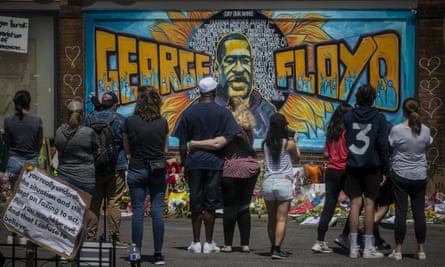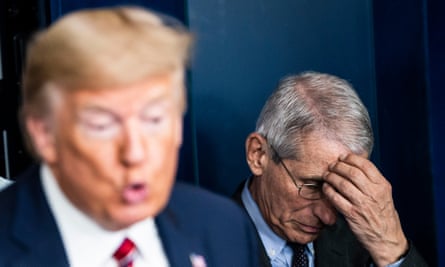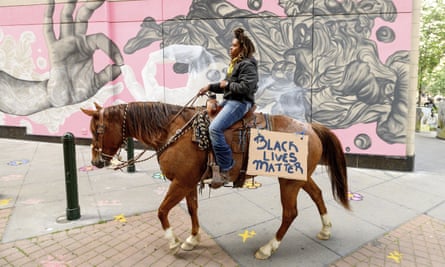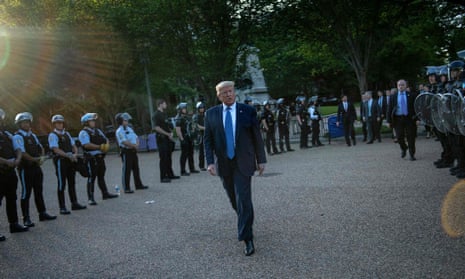Good morning.
Donald Trump walked from the White House to the nearby St John’s Episcopal church on Monday. Not to worship or pray there, as many presidents have done before, but to pose for a photo holding a copy of the bible aloft. Just beforehand, police had used teargas and rubber bullets to clear a crowd of peaceful protesters from his path.
The photo op came shortly after Trump described himself as “your president of law and order”, and threatened to deploy federal troops to quell the nationwide protests over the police killing of George Floyd – a threat that would require him to invoke the 1807 Insurrection Act, last used during the LA riots of 1992.
Church leaders responded to his behaviour with outrage, but the president was unrepentant. Also on Monday, he ranted at governors and other officials that they must “dominate” their states and cities, saying otherwise they would “look like a bunch of jerks.”
This president has “built his entire political career as a gold-painted tower to incite violence,” says Richard Wolffe. And in threatening to deploy the military, writes David Smith, Trump has raised the spectre of fascism:
Comparisons to dictators, fashionable during Trump’s political ascent, have fallen out of favour in recent years. Now they might be in for a comeback.
Barack Obama applauded the peaceful protesters in a Medium post that presented a stark contrast to Trump’s response. The former president offered advice on translating the demonstrations into a “turning point” for the struggle to address structural racism.
The protests go on in big cities, small towns – and overseas
The demonstrations over police brutality and structural racism, inspired by the death of Floyd, continued across the US on Monday night, despite the curfews enacted in New York, Philadelphia and other cities. Protesters marched and chanted from Maine to California, in big cities and small towns, while solidarity protests took place in other nations including the UK and Australia.
A Kentucky police chief was fired on Monday after the mayor learned officers involved in a shooting that killed the popular owner of a local barbecue spot had failed to activate their body cameras during the clash with protesters.
A medical examiner says Floyd’s death was a ‘homicide’

Derek Chauvin, the police officer who knelt on George Floyd’s neck for almost nine minutes, has already been charged with his murder. But calls to charge the other three officers involved in his fatal arrest are growing, after a medical examiner in Minneapolis classified the 46-year-old’s death as a homicide, caused by “a cardiopulmonary arrest while being restrained by law enforcement officer(s).”
The chief of Minneapolis police, Medaria Arradondo, said in an interview on Sunday that the decision over whether to charge the officers would come through the Hennepin county attorney’s office, but added that “all four officers” involved in Floyd’s death were “complicit” in what he described as “a violation of humanity”.
Floyd Mayweather is covering George Floyd’s funeral expenses. The former boxing world champion’s promotional company announced his offer to pay for the funeral on Twitter, and the Floyd family has reportedly accepted it.
Dr Fauci hasn’t spoken to Trump in more than two weeks

For months, Dr Anthony Fauci was the face of the US response to the coronavirus. But on Monday the Trump administration’s top infectious disease expert admitted he had not spoken to the president since 18 May, despite the pandemic’s continued spread through American communities. The news seems likely to raise fears that Fauci has been frozen out by the White House – and that Trump has lost interest in tackling the disease.
The coronavirus crisis continues…
… in Pakistan, where the prime minister, Imran Khan, has lifted lockdown measures to prevent further economic losses, saying people must “live with the virus”. There are concerns, too, about a potential surge in polio cases after 40 million Pakistani children missed out on vaccinations due to the lockdown.
… In Mexico the Covid-19 death toll passed 10,000 on Monday.
… But in New Zealand, lockdown restrictions may be lifted early, after the prime minister, Jacinda Ardern, announced the country was on track to eliminate the virus “ahead of schedule”.
In other news…

More than 500 land mammal species are on the brink of extinction and likely to be lost over the next 20 years, according to scientists who have warned that the sixth mass extinction of wildlife on Earth is accelerating, and may herald the collapse of human civilisation.
Facebook employees are rebelling against Mark Zuckerberg over his refusal to act against Trump’s recent postings, with some senior employees voicing dissent on social media, and others staging an unprecedented “virtual walkout”.
Trump offered to invite Vladimir Putin to the G7 meeting in September, during a call with the Russian leader on Monday. But other members of the group, including the UK and Canada, have already expressed their opposition to Putin’s attendance.
Great reads

Run the Jewels: ‘I’m just rapping about the societal conditions.’
Killer Mike’s impassioned speech about the death of George Floyd went viral last week. He and his Run the Jewels collaborator El-P tell Alexis Petridis about being the right band for the times. “If anything, it’s a source of mild discomfort to us that our music is seemingly relevant.”
The power of crowds
Even before the coronavirus lockdown, the opportunity to gather freely in crowds was under threat from mass surveillance, or the seizure of public space. But whether for protest or celebration, the human desire to form a crowd will persist, writes Dan Hancox.
Opinion: the G20 should be leading us out of the Covid crisis
In 2009, Gordon Brown led a G20 summit at which world leaders come together to forge solutions to the global financial crash. Yet in 2020, Brown writes, the world’s premier forum for international economic cooperation has gone awol amid an even deeper crisis.
This is not just an abdication of responsibility; it is, potentially, a death sentence for the world’s poorest people, whose healthcare requires international aid and who the richest countries depend on to prevent a second wave of the disease hitting our shores.
Last Thing: ‘No one can ignore a black woman on a horse’

Brianna Noble was one of thousands of protesters on the streets of Oakland on Friday. But she was probably the only one riding a horse. “I know that what makes headlines is breaking windows and people smashing things,” the 25 year-old horse trainer told the Guardian. “So I thought, ‘Let’s go out and give the media something to look at that is positive and change the narrative’ … I felt helpless and thought to myself, ‘I’m just another protester if I go down there alone, but no one can ignore a black woman sitting on top of a horse.’”
Sign up
First Thing is delivered to thousands of inboxes every weekday. If you’re not already signed up, subscribe now.
